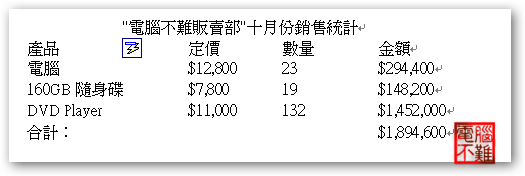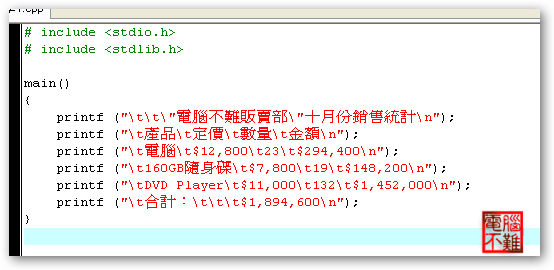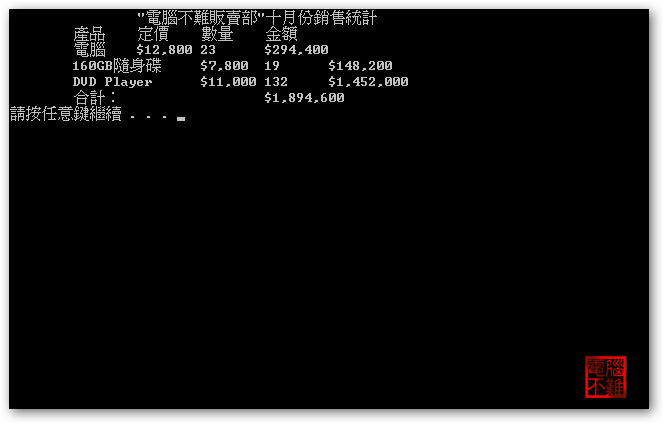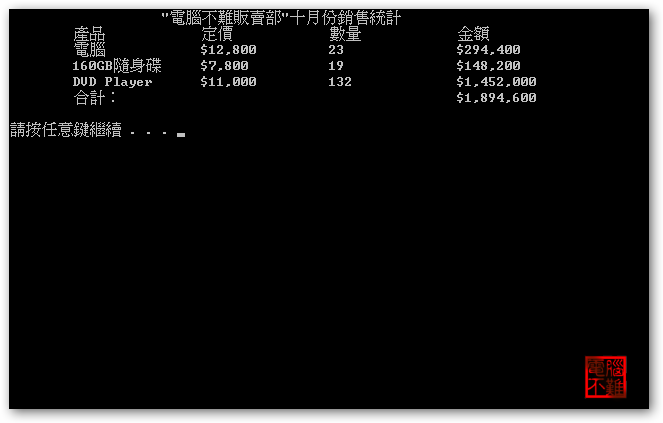Printf 輸出你要的字
這是C語言的第一篇教學文,若你還沒有wxDev-C++編譯器的話,請看這篇
首先瞭解C語言的基本程式架構
(//程式註解)
# include <函式庫>
main()
{
程式內容
}
灰色括號代表可省略
由於C語言不像VB一說就懂
所以我想從範例直接開始講解
不知道怎麼直接說明= =
.
假如說我要用C語言來顯示以上文字,並且排列整齊,就要用到printf
使用「printf」函數就要用到<stdio.h>和<stdlib.h>函式庫
所以我們先撰寫檔頭函式庫
# include <stdio.h>
# include <stdlib.h>
接著還需要一個main函數來撰寫程式
所以皆著撰寫
main ()
再來需要一組大括號「{}」將程式括起來
綜合上面,現在須寫
# include <stdio.h>
# include <stdlib.h>main()
{}
接著就可以開始在{}內撰寫程式碼啦!
注:1.「”」字元在C語言需用「”」來顯示
2.「t」有空一大格的效果
3.「n」可以換行
4.空格可作顯示位置微調
PS! 每一行printf結尾需用「;」,代表著這行程式的結束
撰寫出來的程式大概如下
1 2 3 4 5 6 7 8 9 10 11 12 |
# include <stdio.h> # include <stdlib.h> int main() { printf ("tt"電腦不難販賣部"十月份銷售統計n"); printf ("t產品t定價t數量t金額n"); printf ("t電腦t$12,800t23t$294,400n"); printf ("t160GB隨身碟t$7,800t19t$148,200n"); printf ("tDVD Playert$11,000t132t$1,452,000n"); printf ("t合計:ttt$1,894,600n"); } |
若你現在就開始編譯執行的話,會發現閃出一個黑色的視窗,然後什麼事都沒發生
這是當然的,因為你沒有給程式一個停留指令
所以還需撰寫下面程式:
system (“pause”);
別以為這樣就好了,還需要一個結束指令
所以還需再撰寫下面程式:
return 0 ;
傳回0值,讓系統知道此程式已結束
PS!「system (“pause”);」和「return 0 ;」一樣要撰寫在{}內,而且順序要對,system要在return的上面
撰寫完後按下鍵盤「F9」或用滑鼠左鍵按執行→編譯並執行
接著如圖:
看的出來還需再做調整
所以就邊調整邊執行測試,直到完成排列即可
調整後就會好很多了:
程式碼如下:
1 2 3 4 5 6 7 8 9 10 11 12 13 14 |
# include <stdio.h> # include <stdlib.h> int main() { printf ("tt "電腦不難販賣部"十月份銷售統計n"); printf ("t產品tt定價tt數量tt金額n"); printf ("t電腦tt$12,800tt23tt$294,400n"); printf ("t160GB隨身碟t$7,800tt19tt$148,200n"); printf ("tDVD Playert$11,000tt132tt$1,452,000n"); printf ("t合計:tttttt$1,894,600nn"); system ("pause"); return 0 ; } |



